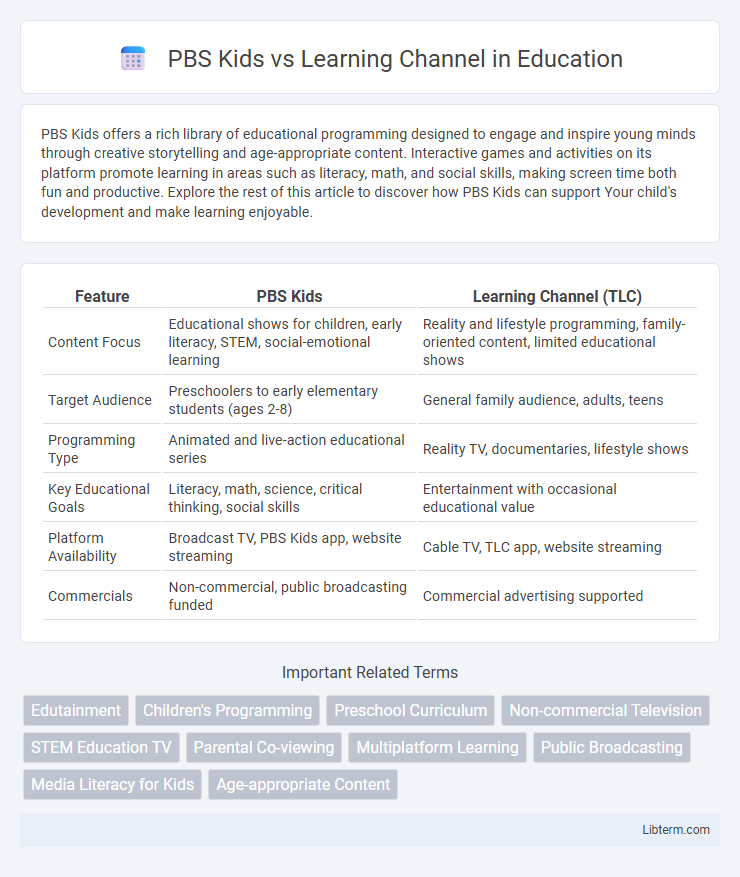PBS Kids offers a rich library of educational programming designed to engage and inspire young minds through creative storytelling and age-appropriate content. Interactive games and activities on its platform promote learning in areas such as literacy, math, and social skills, making screen time both fun and productive. Explore the rest of this article to discover how PBS Kids can support Your child's development and make learning enjoyable.
Table of Comparison
| Feature | PBS Kids | Learning Channel (TLC) |
|---|---|---|
| Content Focus | Educational shows for children, early literacy, STEM, social-emotional learning | Reality and lifestyle programming, family-oriented content, limited educational shows |
| Target Audience | Preschoolers to early elementary students (ages 2-8) | General family audience, adults, teens |
| Programming Type | Animated and live-action educational series | Reality TV, documentaries, lifestyle shows |
| Key Educational Goals | Literacy, math, science, critical thinking, social skills | Entertainment with occasional educational value |
| Platform Availability | Broadcast TV, PBS Kids app, website streaming | Cable TV, TLC app, website streaming |
| Commercials | Non-commercial, public broadcasting funded | Commercial advertising supported |
Introduction: PBS Kids vs Learning Channel
PBS Kids specializes in educational content tailored for children, emphasizing early childhood development through interactive shows and games aligned with curriculum standards. The Learning Channel (TLC) primarily targets adult audiences with reality-based and lifestyle programming, focusing on personal stories, family dynamics, and practical skills. PBS Kids offers a structured, child-friendly learning environment, while TLC provides entertainment and real-life insights suited for a broader, mature viewership.
Overview of PBS Kids
PBS Kids is a leading educational television network designed to provide children with high-quality, curriculum-based programming that fosters early learning in literacy, math, science, and social skills. The channel features beloved characters such as Arthur, Daniel Tiger, and Sesame Street that engage young viewers through interactive content and age-appropriate storytelling. With a strong emphasis on accessibility, PBS Kids offers free programming both on-air and online, making it a trusted resource for parents and educators nationwide.
Overview of Learning Channel
The Learning Channel (TLC) offers educational and reality-based programming that targets a broad audience, including children, teens, and adults, with shows focused on science, history, and personal growth. Unlike PBS Kids, which specializes exclusively in age-appropriate, curriculum-driven content for young children, TLC provides a diverse array of entertaining and informative series designed to engage viewers of all ages. TLC's programming approach blends entertainment with education to create accessible learning experiences beyond formal academic subjects.
Educational Content Comparison
PBS Kids offers a wide range of age-appropriate, curriculum-aligned educational programming targeting preschool to early elementary children, emphasizing literacy, math, science, and social skills. The Learning Channel (TLC) primarily features lifestyle and reality-based content with limited focus on structured educational material, making PBS Kids the superior source for early childhood learning and development. Content on PBS Kids integrates research-based teaching methods and diverse characters to foster engagement and cognitive growth.
Age Group Target Audience
PBS Kids primarily targets children aged 2 to 8 years old, offering educational content designed to promote early childhood development and foundational learning skills. The Learning Channel (TLC) generally appeals to a broader audience, including teens and adults, with programming that ranges from reality shows to lifestyle content rather than strictly educational material for young children. Therefore, PBS Kids is more focused on early education for preschool and early elementary age groups, whereas TLC targets viewers beyond the early childhood demographic.
Programming Styles and Formats
PBS Kids specializes in educational programming for children, featuring animated series, interactive games, and live-action shows designed to promote learning through storytelling and play-based methods. The Learning Channel (TLC) airs reality-based content focusing on lifestyle, family dynamics, and personal stories, often formatted as docuseries and reality competitions that emphasize real-life experiences. While PBS Kids emphasizes curriculum-driven content and age-appropriate educational goals, TLC prioritizes entertainment through relatable, unscripted programming aimed at a broader adult audience.
Accessibility and Platforms
PBS Kids offers extensive accessibility through free streaming on multiple platforms including smart TVs, mobile apps, and its website, ensuring broad availability without subscription fees. The Learning Channel (TLC) primarily requires a cable subscription or streaming service login, limiting access compared to PBS Kids. PBS Kids' dedicated apps and user-friendly interface cater specifically to children, enhancing educational engagement across diverse devices.
Parental Controls and Safety
PBS Kids offers robust parental controls featuring customizable content filters and screen time limits, designed to ensure a safe viewing environment for young children. The Learning Channel provides parental controls through its streaming platforms, allowing parents to restrict access to mature content and set viewing profiles, though these features are often less comprehensive than PBS Kids' child-focused safety tools. Both networks prioritize children's safety, but PBS Kids delivers a more specialized approach tailored to early childhood educational content and secure media consumption.
User Experience and Engagement
PBS Kids offers an intuitive interface designed specifically for children, featuring vibrant visuals and easy navigation that enhances user engagement and retention. The Learning Channel (TLC) provides diverse content aimed at a broader demographic, with interactive features such as polls and social media integration that boost viewer participation. User experience on PBS Kids prioritizes educational value and age-appropriate content delivery, while TLC focuses more on lifestyle and reality programming that engages viewers through real-life stories and emotional connection.
Pros and Cons of Each Platform
PBS Kids offers high-quality educational content designed specifically for young children, promoting early literacy, math, and social skills through engaging characters and interactive games; however, its programming is primarily limited to preschool and early elementary age groups. Learning Channel (TLC) presents a wider variety of reality-based and lifestyle programming catering to older children and adults, which includes informative documentaries and family-oriented shows but may lack the focused educational curriculum found on PBS Kids. Both platforms provide valuable learning opportunities, with PBS Kids excelling in structured early childhood education and TLC offering broader entertainment that can stimulate curiosity across diverse interests and age ranges.
PBS Kids Infographic

 libterm.com
libterm.com